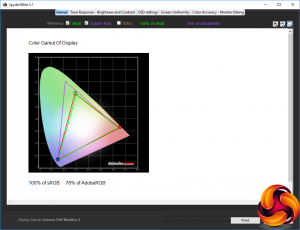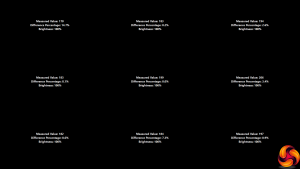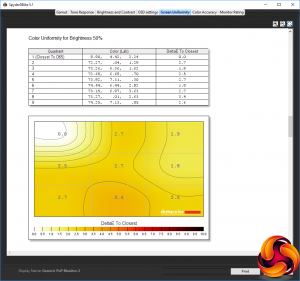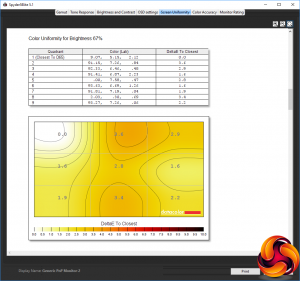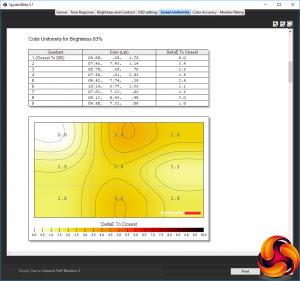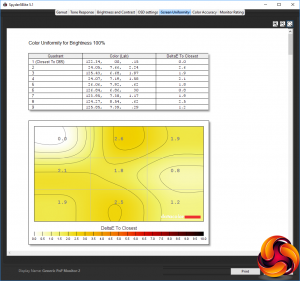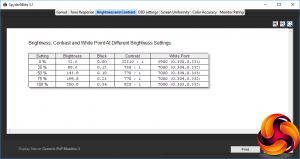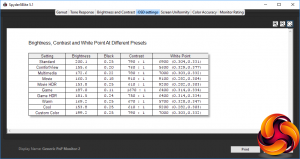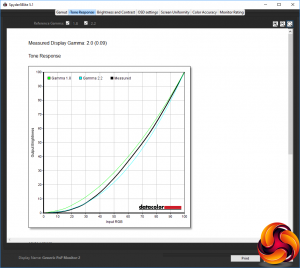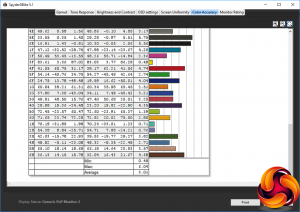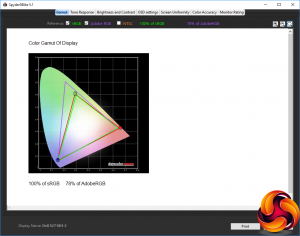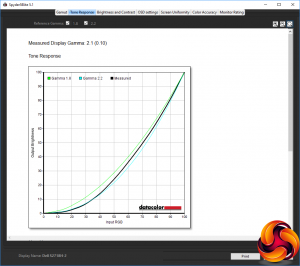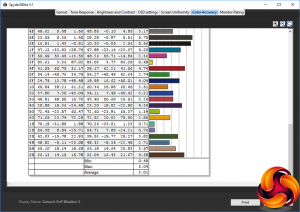Our main test involves using a DataColor Spyder Elite 5 Colorimeter to assess a display’s image quality. The device sits on top of the screen while the software generates colour tones and patterns, which it compares against predetermined values to work out how accurate the screen is.
The results show –
- A monitor’s maximum brightness in candelas or cd/m2 at various levels set in the OSD.
- A monitor’s contrast ratio at various brightness levels in the OSD.
- The brightness deviation across the panel.
- The black and white points
- The colour accuracy, expressed as a Delta E ratio, with a result under 3 being fine for normal use, and under 2 being great for colour-accurate design work.
- The exact gamma levels, with a comparison against preset settings in the OSD.
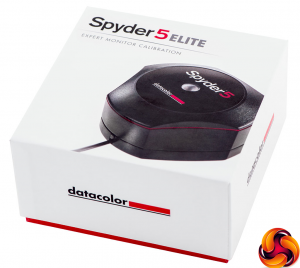
We first run this test with the display in its default, out-of-the-box state, with all settings on default. We then calibrate the screen using the Spyder software and run the test again.

We always test the display subjectively on the Windows desktop, using it for general tasks such as browsing and word processing, and with games as well, even if the display is not intended solely for that purpose. We pay careful attention to any artefacts, ghosting or motion blur, and enable any gaming specific features, such as adaptive-sync settings like G-Sync, using a compatible graphics card in our test PC.
In the case of the S2718H, we performed the primary testing at the native 1,920 x 1,080 resolution in the default mode with the Standard Preset, apart from during the section that actually tests presets. We left the monitor at 60Hz, which is the default, although it can reach 75Hz at resolutions lower than 1,920 x 1,080. Our test system was equipped with an NVIDIA Quadro K2200.
Gamut is very commendable, as you expect from an IPS screen. The S2718H can display 100 per cent of sRGB and a healthy 78 per cent of AdobeRGB.
Brightness uniformity is a bit of a mixed bag, with the top-left corner, top middle and left side showing more aberration than the rest of the screen, which fares better.
Colour uniformity is reasonable at all brightness levels from 50 to 100 per cent, which is commendable.
The brightness level at 100 per cent setting is reassuringly higher than the 250cd/m2 rating, coming in at 280.8cd/m2, with a reasonable 820:1 contrast. At the default 75 per cent brightness, the level is 199.8cd/m2, with contrast down to 770:1. The black level drops fairly uniformly as brightness is reduced, but the white point remains very constant at 7,000K, with just a step to 6900K at 0 brightness.
There are lots of OSD presets available with the S2718H, and they're very varied too. The Standard mode sits at 200.1cd/m2, with a 0.25 black point, 790:1 contrast and 6900K white point – all pretty expected for a mid-range option. ComfortView drops the brightness down to 155.6cd/m2, with a slightly lower 760:1 contrast and warmer 5,600K white point.
The Multimedia option sits in between Standard and ComfortView for brightness at 172.6cd/m2 and contrast at 780:1. The white point is a little cooler at 7,000K. The Movie presets both have very cool points, with the standard one using 9,100K and the HDR version 9,200K. Brightness is around the same at 160.3 and 153.8cd/m2 respectively. But the black points vary as does contrast, with the standard Movie mode offering a high 910:1 but the HDR version opting for 610:1, as you might expect for a setting that aims to bring out highlights and shadows.
The Game modes offer a similar contrast to the Movie modes. The non-HDR version is a little brighter at 187cd/m2 versus 181.5 for HDR, and the white point is identical at 6,400K, but the black point is lower, and contrast ranges from 1,670:1 for non-HDR to 750:1 for the HDR version. We will be talking about these HDR modes a bit more later.
Finally, the Warm mode unsurprisingly has a warm white point of 5,700K and Cool mode a cool white point of 9,200K. The black point is the same for both at 0.25, and brightness not that different with 169.2cd/m2 for Warm and 153.8cd/m2 for Cool. Similarly, contrast remains in the same ballpark at 670:1 and 610:1 respectively. Custom Color isn't any different to Standard mode, until you adjust the RGB sliders that appear when this mode is selected.
With no gamma settings, the Standard preset provides a pretty spot-on gamma curve of 2.0, which is a little low for a mid-range setting, where 2.2 would be more normal.
Colour accuracy is merely decent at 3.01 average variance. This is not in the same league as the factory-calibrated Dell UltraSharp U2417H.
We hoped we could do better with a bit of adjustment, so we calibrated the screen using the Spyder to find if this would improve matters.
As we usually find, the gamut hasn't changed, with the same commendable 100 per cent of sRGB and 78 per cent of Adobe RGB.
The gamma has increased to 2.1, which is closer to what we would expect from a mid-range setting.
Colour accuracy has improved a bit too, reaching 2.72, which means the process was worth doing. It's still only a reasonable score, and no match for Dell's UltraSharp U2417H, but then you pay a lot more for screens in this range.
We also tried some games and movies, which were pleasant enough. Without any high refresh modes, there's none of the ultra-smooth frame rates found with top-end gaming screens, and as our test system had NVIDIA graphics, FreeSync wasn't enabled. We tried the two HDR modes (Movie and Game) and found their effects very subtle. There is a slight improvement of detail in bright or shadowy areas, but it's hardly a huge leap.
One area where the S2718H does punch a little above its price is in the quality of the built-in audio. This is noticeably better than the average display sound, with greater range and more volume available. We would still turn to separate speakers for music enjoyment or gaming, but the quality is more than enough for business use.
Overall, though, the S2718H produces a mid-range performance for a screen with a mid-range price and specification, which is about as you would expect. This is a competent all-rounder but nothing special.
Be sure to check out our sponsors store EKWB here
 KitGuru KitGuru.net – Tech News | Hardware News | Hardware Reviews | IOS | Mobile | Gaming | Graphics Cards
KitGuru KitGuru.net – Tech News | Hardware News | Hardware Reviews | IOS | Mobile | Gaming | Graphics Cards


